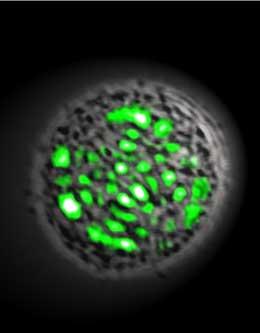摘要:科学家首次利用人类的细胞以及一些水母的蛋白产生了激光。Seok-Hyun Yun是哈佛医学院以及波士顿马萨诸塞州综合医院的的光物理学家,他和他的同事Malte Gather一起创建了这种“活的激光器”,他说:“这是我们第一次用生物材料产生了激光。”《自然-光子学》6月12日报道了这项新的发现。

Microscope image of a living laser in action.
产生激光通常要有3个要素,第一是光源,第二是受激产生激光的“增益介质”(gain medium),第三是将所产生的光聚拢到一起的“光学共振腔”。在过去,增益介质只来自于非生物物质,如掺杂晶体、半导体或气体。而美国马萨诸塞州综合医院的研究人员却发现,可以利用细胞来充当增益介质。
研究人员对一些人体肾细胞进行改造,使其能够产生一种绿色荧光蛋白。这种绿色荧光蛋白发现自会发光的水母,只要用蓝光照射,它就会发出绿色荧光。研究人员将这样的一个肾细胞放在由两面微小镜子组成的光学共振腔中,共振腔的宽度只有20微米。在用蓝光照射后,光学共振腔中果然放射出了激光。虽然这种激光很微弱,但能被清晰地探测到,而用于生成激光的这个细胞仍然存活。
相关专家一致认为这是一项富有创造性的工作。美国加州大学欧文分校的生物医学工程师Michael Berns认为:相对于在医疗方面的应用价值,该技术在单个细胞的研究方面可能会有更加切实可行的应用。 他指出,激光的产生需要外部光源的刺激作用,在机体内这是很难做到的,由此可能限制了该技术在薄组织系统或悬浮细胞中的应用。
生物探索推荐英文原文:
Human cell bocomes living laser
Scientists have for the first time created laser light using living biological material: a single human cell and some jellyfish protein.
"Lasers started from physics and are viewed as engineering devices," says Seok-Hyun Yun, an optical physicist at Harvard Medical School and Massachusetts General Hospital in Boston, who created the 'living laser' with his colleague Malte Gather. "This is the first time that we have used biological materials to build a laser and generate light from something that is living." The finding is reported today in Nature Photonics 1.
Building a laser requires two things: a lasing material that amplifies light from an external source (a 'gain medium') and an arrangement of mirrors (an 'optical cavity'), which concentrates and aligns the light waves into a tight beam. Until now, the gain medium has only been made from non-biological substances such as doped crystals, semiconductors or gases, but in this case the researchers used enhanced green fluorescent protein (GFP) — the substance that makes jellyfish bioluminescent, which is used extensively in cell biology to label cells.
The team engineered human embryonic kidney cells to produce GFP, then placed a single cell between two mirrors to make an optical cavity just 20 micrometres across. When they fed the cell pulses of blue light, it emitted a directional laser beam visible with the naked eye — and the cell wasn't harmed.
The width of the laser beam is "tiny" and "fairly weak" in its brightness compared to traditional lasers, says Yun, but "an order of magnitude" brighter than natural jellyfish fluorescence, with a "beautiful green" colour.
Illuminating biology
Yun and Gather have some broad and speculative ideas about how the technology might be used.
They suggest that biologists could turn cells of interest into lasers to study them. The light produced has a unique emission spectrum related to both the structure of the cell and the proteins inside it. "By analysing the pattern you can get some idea of what is happening inside the cell," says Yun.
The researchers also suggest possible medical applications. Doctors today shine lasers into the body to gather images or to treat disease by attacking cells. Yun thinks that lasers could instead be generated or amplified inside the body, where they could penetrate the relevant tissues more deeply.
But more work is needed first — including developing the laser so that it works inside an actual living organism. To achieve this, Yun envisages integrating a nano-scale optical cavity into the laser cell itself. Technologies to make such cavities are emerging, he says, and once they are available they could be used to create a cell that could "self lase" from inside tissue.
Experts praise the work as interesting and creative. "It is kind of neat," says Michael Berns, a biomedical engineer at the University of California, Irvine. "I have been working on cells and lasers for 40 years, and I don't think I would have thought of this."
But he says that the technique might more feasibly be used to study individual cells than for medical applications. He points out that external light is needed to stimulate the laser action, which would be difficult in the body, potentially limiting the technique to thin-tissue systems or cells in culture or suspension.







